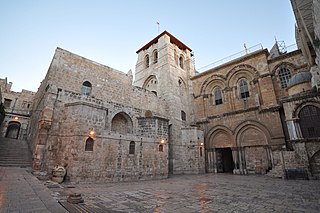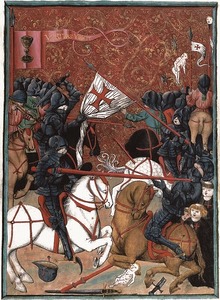
The Inquisition was a group of institutions within the Catholic Church whose aim was to combat heresy, conducting trials of suspected heretics. Studies of the records have found that the overwhelming majority of sentences consisted of penances, but convictions of unrepentant heresy were handed over to the secular courts, which generally resulted in execution or life imprisonment. The Inquisition had its start in the 12th-century Kingdom of France, with the aim of combating religious deviation, particularly among the Cathars and the Waldensians. The inquisitorial courts from this time until the mid-15th century are together known as the Medieval Inquisition. Other groups investigated during the Medieval Inquisition, which primarily took place in France and Italy, include the Spiritual Franciscans, the Hussites, and the Beguines. Beginning in the 1250s, inquisitors were generally chosen from members of the Dominican Order, replacing the earlier practice of using local clergy as judges.

Pope Gregory IX was head of the Catholic Church and ruler of the Papal States from 19 March 1227 until his death in 1241. He is known for issuing the Decretales and instituting the Papal Inquisition, in response to the failures of the episcopal inquisitions established during the time of Pope Lucius III, by means of the papal bull Ad abolendam, issued in 1184.

The Avignon Papacy was the period from 1309 to 1376 during which seven successive popes resided in Avignon rather than in Rome. The situation arose from the conflict between the papacy and the French crown, culminating in the death of Pope Boniface VIII after his arrest and maltreatment by Philip IV of France. Following the subsequent death of Pope Benedict XI, Philip forced a deadlocked conclave to elect the French Clement V as pope in 1305. Clement refused to move to Rome, and in 1309 he moved his court to the papal enclave at Avignon, where it remained for the next 67 years. This absence from Rome is sometimes referred to as the "Babylonian captivity of the Papacy".

Charles I, commonly called Charles of Anjou or Charles d'Anjou, was a member of the royal Capetian dynasty and the founder of the second House of Anjou. He was Count of Provence (1246–1285) and Forcalquier in the Holy Roman Empire, Count of Anjou and Maine (1246–1285) in France; he was also King of Sicily (1266–1285) and Prince of Achaea (1278–1285). In 1272, he was proclaimed King of Albania, and in 1277 he purchased a claim to the Kingdom of Jerusalem.
An edict of toleration is a declaration, made by a government or ruler, and states that members of a given religion will not be persecuted for engaging in their religious practices and traditions. The edict implies tacit acceptance of the religion rather than its endorsement by the ruling power.

The Crusading movement was a framework of ideologies and institutions that described, regulated, and promoted the Crusades. Members of the Church defined the movement in legal and theological terms based on the concepts of holy war and pilgrimage. Theologically, the movement merged ideas of Old Testament wars that were instigated and assisted by God with New Testament ideas of forming personal relationships with Christ. The concept of crusading as holy war was based on the ancient idea of just war, in which an authority initiates the war, there is just cause, and the war is waged with pureness of intention. Adherents saw Crusades as special pilgrimages—a physical and spiritual journey under the authority and protection of the Church. Pilgrimage and crusade were penitent acts and they considered participants part of Christ's army. While this was only metaphorical before the First Crusade, the concept transferred from the clergy to the wider world. Crusaders attached crosses of cloth to their outfits, marking them as followers and devotees of Christ, responding to the biblical passage in Luke 9:23 which instructed them to carry one's cross and follow Christ. Anyone could be involved and the church considered those who died campaigning martyrs. After the First Crusade the movement became an important part of late-medieval western culture, impacting politics, the economy and society.

Caesaropapism is the idea of combining the social and political power of secular government with religious power, or of making secular authority superior to the spiritual authority of the Church; especially concerning the connection of the Church with government. Although Justus Henning Böhmer (1674–1749) may have originally coined the term caesaropapism (Cäseropapismus), it was Max Weber (1864–1920) who wrote that "a secular, caesaropapist ruler... exercises supreme authority in ecclesiastic matters by virtue of his autonomous legitimacy." According to Weber, caesaropapism entails "the complete subordination of priests to secular power."

The Kingdom of Sicily was a state that existed in the south of the Italian Peninsula and for a time the region of Ifriqiya from its founding by Roger II of Sicily in 1130 until 1816. It was a successor state of the County of Sicily, which had been founded in 1071 during the Norman conquest of the southern peninsula. The island was divided into three regions: Val di Mazara, Val Demone and Val di Noto.

Anti-Protestantism is bias, hatred or distrust against some or all branches of Protestantism and/or its followers.

The Crusades were a series of religious wars initiated, supported, and sometimes directed by the Christian Latin Church in the medieval period. The best known of these military expeditions are those to the Holy Land in the period between 1095 and 1291 that were intended to conquer Jerusalem and its surrounding area from Muslim rule. Beginning with the First Crusade, which resulted in the conquest of Jerusalem in 1099, dozens of military campaigns were organised, providing a focal point of European history for centuries. Crusading declined rapidly after the 15th century.
The history of Christian thought has included concepts of both inclusivity and exclusivity from its beginnings, that have been understood and applied differently in different ages, and have led to practices of both persecution and toleration. Early Christian thought established Christian identity, defined heresy, separated itself from polytheism and Judaism and invented supersessionism. In the centuries after Christianity became the official religion of Rome, some scholars say Christianity became a persecuting religion. Others say the change to Christian leadership did not cause a persecution of pagans, and that what little violence occurred was primarily directed at non-orthodox Christians.

The War of the Sicilian Vespers, also shortened to the War of the Vespers, was a conflict waged by several medieval European kingdoms over control of Sicily from 1282 to 1302. The war, which started with the revolt of the Sicilian Vespers, was fought over competing dynastic claims to the throne of Sicily, and grew to involve the Kingdom of Aragon, the House of Anjou, France, and the papacy.

Heresy is any belief or theory that is strongly at variance with established beliefs or customs, particularly the accepted beliefs or religious law of a religious organization. A heretic is a proponent of heresy.

The Eastern Roman (Byzantine) imperial church headed by Constantinople continued to assert its universal authority. By the 13th century this assertion was becoming increasingly irrelevant as the Eastern Roman Empire shrank and the Ottoman Turks took over most of what was left of the Byzantine Empire. The other Eastern European churches in communion with Constantinople were not part of its empire and were increasingly acting independently, achieving autocephalous status and only nominally acknowledging Constantinople's standing in the Church hierarchy. In Western Europe the Holy Roman Empire fragmented making it less of an empire as well.

The 14th century saw major developments in Christianity, including the Western Schism, the decline of the Crusades, and the appearance of precursors to Protestantism.

Christianity in the Middle Ages covers the history of Christianity from the fall of the Western Roman Empire. The end of the period is variously defined. Depending on the context, events such as the conquest of Constantinople by the Ottoman Empire in 1453, Christopher Columbus's first voyage to the Americas in 1492, or the Protestant Reformation in 1517 are sometimes used.
Sectarian violence among Christians is a recurring phenomenon, in which Christians engage in a form of communal violence known as sectarian violence. This violence can often be attributed to differences of religious beliefs between sects of Christianity (sectarianism). Sectarian violence among Christians was common especially during late antiquity and the years surrounding the protestant reformation, in which a German monk named Martin Luther disputed some of the Catholic Church's practices; particularly the doctrine of Indulgences, and was crucial in the creation of a new sect of Christianity known as Protestantism. During the latter half of the Renaissance was when sectarianism related violence was most common among Christians. Conflicts like the European wars of religion or Dutch Revolt ravaged Western Europe. In France there were the French Wars of Religion and in the United Kingdom anti-Catholic hate was heightened by the Gunpowder Plot of 1605. And while sectarian violence may seem like an archaic footnote today, sectarian violence among Christians still persists in the modern world with groups such as the Ku Klux Klan perpetuating violence among Catholics.
The Crusade of the Poor was an unauthorised military expedition—one of the so-called "popular crusades"—undertaken in the spring and summer of 1309 by members of the lower classes from England, Flanders, Brabant, northern France and the German Rhineland. Responding to an appeal for support for a crusade to the Holy Land, the men, overwhelmingly poor, marched to join a small professional army being assembled with Papal approval. Along the way, they engaged in looting, persecution of Jews and combat with local authorities. None of them reached the Holy Land and their expedition was ultimately dispersed.
Crusades against Christians were Christian religious wars dating from the 11th century First Crusade when papal reformers began equating the universal church with the papacy. Later in the 12th century focus changed onto heretics and schismatics rather than infidels. Holy wars were fought in northern France, against King Roger II of Sicily, various heretics, their protectors, mercenary bands and the first political crusade against Markward of Anweiler. Full crusading apparatus was deployed against Christians in the conflict with the Cathar heretics of southern France and their Christian protectors in the 13th . This was given equivalence with the Eastern crusades and supported by developments such as the creation of the Papal States. The aims were to make the crusade indulgence available to the laity, the reconfiguration of Christian society, and ecclesiastical taxation.














